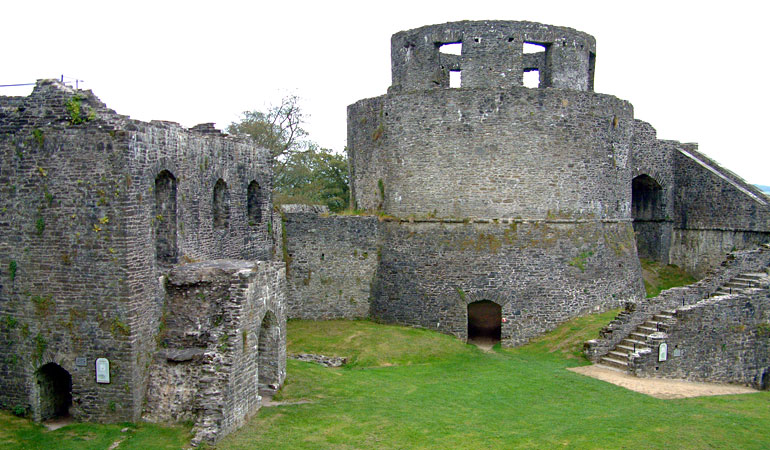Dinefwr Castle was the capital seat of the kingship of Deheubarth. Although legends provide it with a much longer history, there is no evidence that the castle existed before the reign of Rhys ap Gruffudd in the late 12th century. Lord Rhys had managed to create a strong Welsh kingdom which was even recognised by the King of England. On his death in 1197, Rhys's sons contested the succession to the kingdom of Deheubarth. For the next two decades the land and castles were constantly fought over, and it was not until the intervention of Llywelyn the Great in 1216 that a settlement was reached by which the kingdom was divided into three parts. Rhys Gryg gained possession of Ystrad Tywi which included the castle of Dinefwr, and he was probably responsible for the earliest stone structures that remain at the castle, including the circular keep.
When Rhys Gryg died in 1233 his territory was divided between his sons, Rhys Mechyll who inherited Dinefwr and Maredudd who inherited Dryslwyn. The two castles were less than five miles apart, but their inhabitants made poor neighbours. Rhys Mechyll died in 1244 and he was succeeded by his son Rhys Fychan. Maredudd supported the cause of Llywelyn ap Gruffud who was trying to create a united Welsh kingdom, while Rhys Fychan supported the English king. In 1256 Llywelyn invaded Ystrad Tywi and ousted Rhys Fechan from Dinefwr giving Maredudd control of the land. An attempt to recapture his lands with the support of an English force failed, but Rhys Fechan had his territory restored by Llwelyn who was keen to mend divisions between the Welsh princes. This action did nothing to improve the relationship between the two, or indeed their support for Llwelyn, by whom they both felt betrayed. Their animosity remained until their deaths, just three weeks apart in 1271.
In 1277 the English king, Edward I, sent an army into Wales to destroy the power base that Llywelyn had created. Rhys ap Maredudd of Dryslwyn and Rhys Wynod at Dinefwr sought terms with the king and were allowed to keep most of their land, but Dinefwr was confiscated and fell under English control. Rhys Wynod joined the rebellion led by Dafydd ap Gruffudd, but was eventually captured and sent to the Tower of London. In 1287 Rhys ap Maredudd enraged by years of border disputes with his English neighbours, captured the castles of Dinefwr, Carreg Cennen and Llandovery. The English response was swift and an army of 11,000 men recaptured the castles and defeated Rhys ap Maredudd after a three week siege at Dryslwyn. Rhys escaped but was eventually captured and executed for treason. Ystrad Tywi was now entirely under English control.
Following these battles the English repaired and strengthened the castles and new buildings were added inside Dinefwr. In 1317 Dinefwr was given to Hugh Despenser, the king's favourite. Despenser was very unpopular among the Marcher Lords who rose up in revolt against him and attacked his Welsh properties including Dinefwr castle. Extensive repairs were made following this attack and again after a failed siege by Owain Glyn Dwr in 1403. By the end of the 15th century the castle was falling into ruin having been abandoned in favour of a new house (Newton House) built close by. Later occupants of Newton House added a summer house to the top of the circular keep at Dinefwr giving the keep the rather strange appearance that it now has.
Dinefwr Castle is owned by the Wildlife Trust West Wales and is maintained by CADW. However it is still situated in the park created around Newton House, which is owned by the National Trust. Visitors to the castle must therefore pay for entrance to Dinefwr Park in order to see the castle.
- Location:
- Dinefwr Castle is situated in the National Trust owned Dinefwr Park on the outskirts of Llandeilo
- Address:
- Dinefwr Castle, Dinefwr Park, Llandeilo, Carmarthenshire, SA19 6RT
- Access:
- The castle is maintained by CADW and there is free access to it, however it is in the grounds of the National Trust owned Dinefwr Park for which there is an entrance fee
- Website:
- For further information visit cadw.wales.gov.uk
View Larger Map







